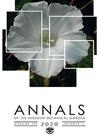一些panicae和paspasae物种的染色体数目和倍性水平(禾本科,Panicoideae)
IF 1.3
3区 生物学
Q3 PLANT SCIENCES
引用次数: 3
摘要
摘要给出了来自阿根廷、古巴和巴西的17种番石榴科24份材料的染色体数目和倍性水平。大多数被研究的物种都是特有种。研究的分类群为:金黄色Axonopus aureus P.Beauv。,艾基阴道双花虫(Swallen)Zuloaga,D.stipiflorum(Renvoize)Zuloega,D.surructum(Chase ex Zuloaga&Morrone)Zuloga,Homolepis isocalycia(G.Mey.)Chase,Paspalum arenarium Schrad。,P.blodgettii Chapm。,P.capillifolium Nash、P.coryphaeum Trin。,P.distortrum Chase,P.durifolium Mez,P.lindenianum A.Rich。,寡穗藻。前Steud。,P.pumilum Nees、P.scutatum Nees ex Trin。,P.strigosum Döll ex Chase和Plagiantha tenella Renvoize;其中,首次报道了A.quivaginatum、D.stipiflorum、D.surectum(n=9)、Homolepis isocalycia(n=20)、Paspalum capillifolium、P.distortrum、P.lindenianum、P.oligostachyun和P.strigosum(n=10)的染色体数目。发现了一种新的金发雀鲷二倍体细胞型(n=10)。本文章由计算机程序翻译,如有差异,请以英文原文为准。
Chromosome Numbers and Ploidy Levels of Some Paniceae and Paspaleae Species (Poaceae, Panicoideae)
Abstract Chromosome numbers and ploidy levels of 24 accessions of 17 species of tribe Panicoideae from Argentina, Cuba, and Brazil are given. Most of the studied species are endemics. The studied taxa are: Axonopus aureus P. Beauv., Dichanthelium aequivaginatum (Swallen) Zuloaga, D. stipiflorum (Renvoize) Zuloaga, D. surrectum (Chase ex Zuloaga & Morrone) Zuloaga, Homolepis isocalycia (G. Mey.) Chase, Paspalum arenarium Schrad., P. blodgettii Chapm., P. capillifolium Nash, P. coryphaeum Trin., P. distortum Chase, P. durifolium Mez, P. lindenianum A. Rich., P. oligostachyum Salzm. ex Steud., P. pumilum Nees, P. scutatum Nees ex Trin., P. strigosum Döll ex Chase, and Plagiantha tenella Renvoize; of these, the chromosome numbers of D. aequivaginatum, D. stipiflorum, D. surrectum (n = 9), Homolepis isocalycia (n = 20), Paspalum capillifolium, P. distortum, P. lindenianum, P. oligostachyum, and P. strigosum (n = 10) are presented for the first time. A new diploid cytotype (n = 10) for Paspalum blodgettii was found.
求助全文
通过发布文献求助,成功后即可免费获取论文全文。
去求助
来源期刊
CiteScore
3.60
自引率
0.00%
发文量
15
期刊介绍:
The Annals of the Missouri Botanical Garden is a quarterly international journal primarily devoted to systematic botany and evolutionary biology. We encourage submissions of original papers dealing with significant advances in the taxonomy, phylogeny, biogeography, paleobiology, and evolution of plants, and in conservation genetics and biology, restoration ecology, and ethnobiology, using morphological and/or molecular characters, field observations, and/or database information. We also welcome reviews and papers on conceptual issues and new methodologies in systematics. Important floristic works will also be considered. Symposium proceedings discussing a broader range of topical biological subjects are also published, typically once a year. All manuscripts are peer-reviewed by qualified and independent reviewers.

 求助内容:
求助内容: 应助结果提醒方式:
应助结果提醒方式:


